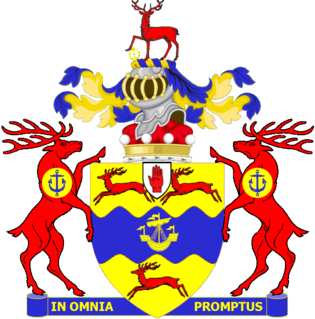Related Research Articles

Earl Marshal is a hereditary royal officeholder and chivalric title under the sovereign of the United Kingdom used in England. He is the eighth of the Great Officers of State in the United Kingdom, ranking beneath the Lord High Constable and above the Lord High Admiral. A Duke of Norfolk has held the office since 1672.

Baron Rea, of Eskdale in the County of Cumberland, is a title in the Peerage of the United Kingdom. It was created in 1937 for the businessman and Liberal politician Sir Walter Rea, 1st Baronet, who had earlier represented Scarborough, Bradford North and Dewsbury in the House of Commons. He had already been created a Baronet, of Eskdale in the County of Cumberland, in 1935. He was succeeded by his eldest son, the second Baron. During the Second World War he served as personal staff officer to Brigadier Colin Gubbins, the Head of SOE, a key British intelligence and guerrilla operations agency. Lord Rea served as Leader of the Liberal Party in the House of Lords from 1955 to 1967. His daughter, the Right Hon. Ann Felicity Rea, married SOE veteran Malcolm Munthe in 1945. His nephew, the third Baron, who succeeded in 1981, was a physician. He was one of the ninety elected hereditary peers elected to remain in the House of Lords after the passing of the House of Lords Act 1999, and sat on the Labour benches. As of 2020 the titles are held by his son, the fourth Baron, who succeeded his father in that year.
David of Scotland was a Scottish prince and 8th Earl of Huntingdon. He was, until 1198, heir to the Scottish throne.

Gervase Babington (1549/1550–1610) was an English churchman, serving as the Bishop of Llandaff (1591–1594), Bishop of Exeter (1594–1597) and Bishop of Worcester in 1597–1610. He was a member of the Babington family and held influential offices at the same time as his cousin Anthony Babington was executed for treason against Elizabeth I as part of the Babington Plot.

Earl of Nithsdale was a title in the Peerage of Scotland. It was created in 1620 for Robert Maxwell, 9th Lord Maxwell, with remainder to heirs male. He was made Lord Maxwell, Eskdale and Carlyle at the same time. The title of Lord Maxwell had been created in the Peerage of Scotland in 1445 for Herbert Maxwell.
The Abbot of Paisley was the head of the Cluniac monastic community of Paisley Abbey and its property. The monastery was founded as a priory at Renfrew in 1163, but moved to Paisley in 1169. It became an abbey in 1219. The founder was Walter fitz Alan, Seneschal (Steward) of Scotland. The line of abbots ended when it was turned into a secular lordship for Lord Claud Hamilton in 1587/1592. The following is a list of abbots and commendators:
Coningsby, or The New Generation is an English political novel by Benjamin Disraeli, published in 1844.

The Quiet Gentleman is a Regency novel by Georgette Heyer. Set in the spring of 1816, after the Battle of Waterloo, it is the story of the return home from the wars of the Seventh Earl of St Erth to claim his inheritance.
The Justiciar of Lothian was an important legal office in the High Medieval Kingdom of Scotland.

Clan Colville is a Lowland Scottish clan.
The Prior of Restenneth was the head of the Augustinian canons of Restenneth Priory, Angus. The following is a list of priors and commendators:
Robert II de Brus, le Meschin was a 12th-century Norman noble and 2nd Lord of Annandale. He was the son, perhaps the second son, of Robert de Brus, 1st Lord of Annandale.
George Douglas, Master of Angus was a Scottish Nobleman. The son of Archibald Douglas, 5th Earl of Angus and Elizabeth Boyd, daughter of Robert Boyd, 1st Lord Boyd, he was born at Tantallon Castle and died at the Battle of Flodden.
Sir David de Lindsay, Lord of Crawford and Ercildum, known as "the elder" to distinguish him from his son, was an Anglo-Scottish baron of the 12th and 13th century.
Alice de Lusignan was the first wife of Marcher baron Gilbert de Clare, 7th Earl of Gloucester, and half-niece of King Henry III of England.
Matilda of Chester, Countess of Huntingdon was an Anglo-Norman noblewoman, sometimes known as Maud and sometimes known with the surname de Kevelioc. She was a daughter of Hugh de Kevelioc, 5th Earl of Chester, and the wife of David of Scotland, Earl of Huntingdon.

Sir Gervase Clifton, 1st Baronet, K.B. was an English politician who sat in the House of Commons at various times between 1614 and 1666. He supported the Royalist cause in the English Civil War. He was educated at St John's College, Cambridge.
Robert Avenel was a 12th-century Anglo-Norman magnate. He was ruler of the small former Northumbrian province of Eskdale in Dumfriesshire, as well as Abercorn in West Lothian. He was one of a small number of Anglo-Norman immigrants to have been given a provincial lordship in southern Scotland in the early-to-mid 12th century. For some period in the 1170s he served as Justiciar in Lothian. He also had some part of the township of Innerwick. He seems to have held this of Walter fitz Alan. He passed this on to his younger son Vincent. His nephew Glai or Glay may have held part of Innerwick too.
Gervase of Melkley or Gervase of Melkeley was a Norman scholar and poet.
Sir Robert de Quincy, Justiciar of Lothian was a 12th-century English and Scottish noble.
References
- People of Medieval Scotland Gervase Avenel, lord of Eskdale (d.1219), accessed 3 October 2018.